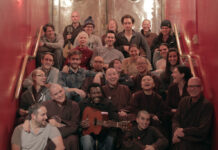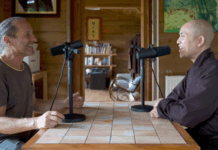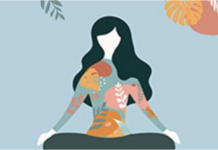Mindfulness of the Body
After discussing Trauma-Sensitive Mindfulness, let’s go back to the progression which works best for most people, most of the time. After tuning in the sensations of your natural breath, patiently, without control or contraction, you can tune in other sensations in your body. Feel your two legs, your trunk, your two arms, and your head, just as they are. Know how your posture is right now, and what your body is in contact with. Try to suffuse, to permeate your whole body with awareness, so that there is no part of your body you’re not aware of. Become aware of all physical sensations at the same time. Your awareness fills your body, and your body is filled with your awareness. If you find you are holding tensions on your face or eyes, just notice the tensions, and allow your face to relax. If you see you are holding unnecessary tensions in your shoulders, give permission to your shoulders to relax, and see if they want to. If you notice you are holding your belly unnecessarily tight, notice the tension, and allow your breath to go deeper. You are aware of your natural breath and all other physical sensations as they are, allowing your whole body to relax, with an open mind, without control or contraction.
Mindfulness of the body is not about thinking about your body, or trying to create any special sensation. It is about establishing a brain-body connection, by tuning in your body as it is and noticing as many sensations as you can, with a sense of acceptance, ease, and relaxation.
Cultivating this brain-body connection in your daily life will enhance your wellbeing. When your mind is in your body, it is more centered, calmer, clearer. You are more attuned to your physical needs, and can make more health-promoting decisions. A healthy mind is an embodied mind, and a healthy body is a body whose signals are received.
Right now, there are countless sensations manifesting and moving in your body, quickly appearing and quickly disappearing. Some of these sensations are pleasant, some unpleasant, and some neutral. Our natural tendency is to pursue the pleasant, run away from the unpleasant, and ignore the neutral. We all do this, all the time. Yet what the Buddha found is that we can touch peace and wholeness in releasing these tendencies. Notice how your physical sensations change: whether they are pleasant, unpleasant, or neutral, all of your bodily sensations are changing. All of your sensations are changing, therefore it doesn’t make much sense to discriminate so much against them. Allow your mind to open up. You are less pulled away by the pleasant, less ignoring the neutral, and less afraid of the unpleasant. You can be with all physical sensations, at the same time. Notice the space it brings to your mind, the absence of division, and the peaceful, wholesome joy in that. Notice how this makes you more available to the present moment, mind, breath, and body united. Isn’t it wonderful to feel whole?
Smile, Stand Tall, Slow Down, and Move Smoothly
There are four little tweaks that can support your mindfulness practice at all times, and the first is to smile. If you have an aversion towards smiling, I totally get it. As a teenage boy growing up in Paris, smiling was one of the least cool thing you could do in life. But I learned how to smile a little bit more, and so far I don’t regret it. So far. The smile we’re talking about here of course is not a commercial smile. It is a very light and gentle smile. It doesn’t even have to be visible. As you follow your breath and are aware of your body, very gently stretch your lips. There is a psychologist named Paul Ekman who studied the link between facial expressions and emotions and found that not only our emotions influence our facial expressions, but our facial expressions also influence our emotions. A gentle smile sends the message to your brain that you are here for yourself. That you’ve got this. And that this moment is good enough. Smile with both the joys and the sorrows. Smile with both the part of you you are proud of, and the part of you you are less proud of – the comfortable part and the uncomfortable part. This is a gentle smile of acceptance and embracing. You are allowing both sides of life to flow into each other. It’s nice, isn’t it? Focusing on your breath, aware of your whole body, smiling gently, you can produce feel-good hormones more or less on demand. You become your own drug dealer. You don’t have to smile all the time when you practice mindfulness. Please don’t hurt your cheeks. But a gentle smile can definitely help, from time to time.
The second tweak which can support your practice is to stand tall. Remember, it’s a two-way street between your body and mind. Your mind influences your body and your body influences your mind. Standing tall and looking a few meters in front of you can boost the quality of your presence. Studies show that a good posture can decrease depression and anxiety, and improve our mood, alertness and self-esteem. Please gently stretch your spine upwards and tuck your chin slightly in. Keep your back quite straight, but only to the extent that feels comfortable. Look a few meters in front of you, and minimize looking side to side in an agitated way. As you learned, you want your nervous system to be nicely active and appropriately responsive. When you catch yourself feeling depressed and looking down, stand tall and look up a little bit, to bring some aliveness and strength into your experience. And when you find yourself agitated or aggressive, look down a little bit to get in touch with your center again. It’s all about balance. Standing tall and looking a few meters in front of you will help you cultivate presence and kindness towards yourself and others.
The third tweak is to slow down. Life is precious and we want to savor it. When you find yourself frantically rushing through your day, you can remind yourself to slow down. You’re slowing down, not to become stiff but to enjoy more, so please only slow down to the extent that still feels natural and enjoyable. When I ordained as a novice monk, I watched my teacher walk super slowly. I tried to walk at the same speed but it didn’t feel so good, and it took me an embarrassingly long time to realize that I had to walk at a different speed. He was a eighty-two year old with short legs, I was a twenty year old with long legs, and the right speed for him was not the right speed for me. So I trained myself to walk and move in a way that feels mindful enough while still respecting the natural energy in my body. When I notice I’m agitated and going too fast, I slow down a bit. And when I notice I’m constraining myself too much, I loosen up a bit. But I think you will agree with me that most people, most of the time are too stressed and need to slow down.
The last tweak you may like to experiment with is to move smoothly. We may not even notice it but so many times during the day we tense up, hold our breath, and move jerkily. Please watch out for these tendencies and allow your breath and movements to stay fluid. Don’t hold unnecessary tensions in your body, whether in your breath, in your muscles or around your joints. When sitting down, standing up, walking around, or doing things, try to move smoothly enough. Moving smoothly helps you relax and makes your mindfulness practice more enjoyable.
Smile, stand tall, slow down, and move smoothly: these are not strict instructions to become a mindfulness machine but gentle suggestions to become a happier human. Experiment with them, see how they make you feel, and use them whenever you find them helpful.
You’re the expert of your life. You will learn mindfulness by practicing it. You will learn from your own experiences, through trial and error. The most important is you remember the basic practice, which is to gently come back to your breath, your body, and the present moment whenever you remember, and to remember why you are doing this, which is to bring more presence, more peace, and more kindness into your life.
Article republished with permission from mentalhealthrevolution.org






















